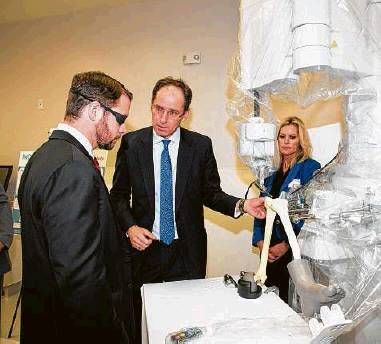Innovation cuts into health care costs
CHRIS TOMLINSON Commentary
Medicine was originally an art — practical magic even — before science took hold, but the future of health care will take a page from the industrial revolution. Health care costs are growing faster than corporate profits, government tax revenues and personal incomes. Scientific breakthroughs are improving lives, but most come with higher costs. Rationing care by means other than price is politically unpalatable. When other markets innovate, prices typically go down. But lack of competition and perverse incentives distort the health care industry, and greed drives prices higher. Dr. Stefan Kreuzer founded Inov8 Orthopedics believing that competing on quality and price is the only way forward for health care. Applying long-established industrial principles, Inov8 has constructed apurpose-built surgical center focused on improving precision and efficiency to give patients the best outcomes at lower costs.
Kreuzer’s business plan seeks to mitigate the industry’s misaligned incentives that encourage higher costs.
The patient’s primary interest is in obtaining great care. In most cases, they pay only a portion of the bill and care little about cost. Everybody wants the world’s best doctor in the most high-tech facility.
Doctors want to provide top-quality care, but they are paid to see as many patients as possible. Most prefer to remain ignorant of costs because they say they do not want billing to influence their professional judgment.
Hospitals make their money from providing infrastructure and supplies with a hefty mark-up. Administrators are compensated for generating profits, often through huge bonuses, regardless of whether the organization is technically nonprofit. So far everyone is incentivized to run up a bill.
The insurance company, employer or government agency that pays the bill wants to control costs because they know patients hate expensive premiums. Adjusters do not want to pay a penny more than is necessary for the care required.
Large and smart employers, such as Walmart, JP Morgan Chase and others, are frustrated by skyrocketing costs and want to inject more competition into health care. For scheduled surgeries, these companies are signing long-term contracts with top doctors and hospitals that promise patient volume in return for competitive prices.
Inov8 Orthopedics intends to enter that competition with a state-of-the-art center that specializes in hip and knee replacements. At the grand opening, Kreuzer showed off the latest robotic tools, laser-guided alignment systems and other amazing innovations in a facility more advanced than many hospitals.
The goal is to undercut those hospitals that so deeply frustrated him for most of his career.
“I said, ‘This is enough; this is unsustainable’ because it was all about doing more, seeing more patients, generating more revenue and increasing health care costs. I just hated it, and I needed to exit that,” he told me. “I just want to reduce health care costs, and in order for me to maintain significant revenue, I needed to own the facility.”
He also needed to change the way he bills for the services. Instead of the facility, surgeon, anesthesiologist and assistants separately billing the insurance company, Kreuzer offers a flat rate in asingle invoice.
By using the best technology, Inov8 intends to reduce errors, speed up surgeries and lower costs. Inov8 charges less to use its facility and slashes the typical mark-up hospitals add to materials and supplies. Inov8 then uses part of the savings to pay surgeons and staff higher rates to focus more on quality. The rest of the savings is used to cut prices.
Kreuzer said his staff can make multiple times more money per surgery from bonuses for quality outcomes, which encourages them to spend more time per patient.
There are no $8 million-a-year CEOs or $500 aspirins at Inov8. But neither is there an emergency department or patients who cannot afford the treatment they need.
Kreuzer is passionate about providing the best care for the lowest price, and we need more companies like Inov8 focused on driving down costs. But big hospitals charge $28,000 for a $4,000 hip implant because they subsidize other services that society depends on, but will not pay for.
Competition and innovation will help reduce some of health care’s high prices, but Inov8’s business plan reveals how people with insurance secretly subsidize those without. The nagging question is what will happen to the needy if that invisible safety net goes away.
Tomlinson writes commentary about business, economics and policy. chris.tomlinson@chron.com twitter.com/cltomlinson


